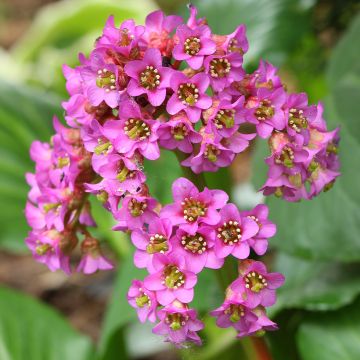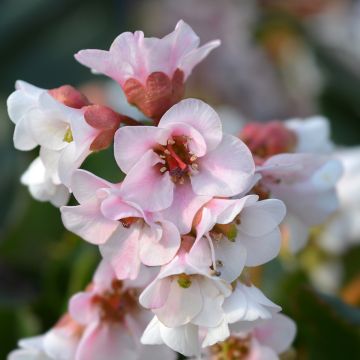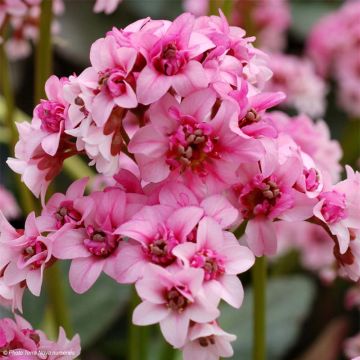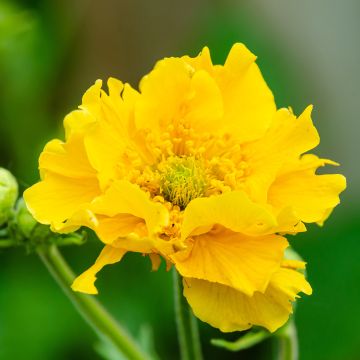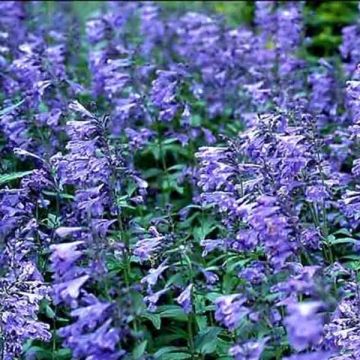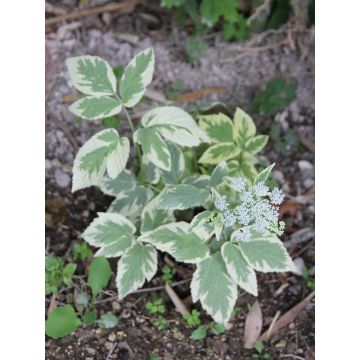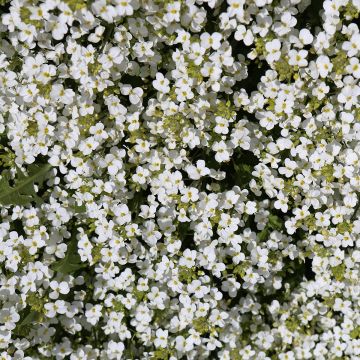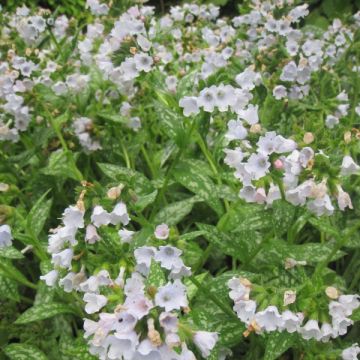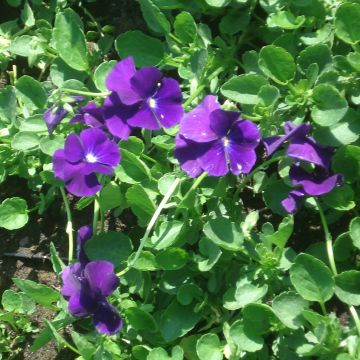

Bergenia Jelle - Elephant's Ears
Bergenia Jelle - Elephant's Ears
Bergenia Jelle
Elephant's Ears, Heartleaf Bergenia, Pigsqueak
This item cannot be shipped to the selected country
Delivery charge from €6.90
More information
Delivery charge from €6.90
More information
Schedule delivery date,
and select date in basket
This plant carries a 12 months recovery warranty
More information
We guarantee the quality of our plants for a full growing cycle, and will replace at our expense any plant that fails to recover under normal climatic and planting conditions.
From €7.90 for pickup delivery and €6.90 for home delivery
Express home delivery from €8.90.

Does this plant fit my garden?
Set up your Plantfit profile →
Description
Bergenia 'Jelle', known as Bergenia or Elephatnt's Ears, is a refreshing novelty. In spring, it produces reddish stems bearing clusters of white flowers with a small green centre, emerging from beautiful undulate, glossy and evergreen green foliage. Over time, this perennial can form beautiful colonies that make for a low but effective and attractive ground cover. It is a variety of discreet elegance, perfect for placement in a cool and shaded rockery or along a pathway.
Bergenia 'Jelle' is a plant from the Saxifragaceae family, of hybrid and horticultural origin. It is a perennial herbaceous evergreen plant, reaching around 35cm (14in) in height, with a creeping habit and vegetation gathered in dense clumps. It grows on a thick, sprawling rhizome enveloped by the sheaths of the base of the leaves. Over time, the plant spreads, but its growth is so slow that it is hardly considered invasive. Secondary stems appear here and there, eventually forming a beautiful carpet. The tough, rosette-shaped, glossy and shiny leaves remain a vibrant green throughout the year, even in winter. They are very thick, heart-shaped, with dentate margins. The flowers, which are mostly carried horizontally, are grouped in panicles. They are white with a green centre, and borne on red-tinted stems that rise well above the foliage. They appear in late winter or early spring but bloom in the heart of spring, in April-May.
Bergenia 'Jelle' will thrive in most soils, but a humus-rich and moist soil is preferable. Overly dry soils tend to limit its growth. It will prosper in shade, partial shade or sunny positions, but not scorching sun: dense shade should be avoided, as it prevents flowering, as well as intense sunlight. Cold weather and poor soils enhance its colours. If you are looking for an elegant and sturdy perennial that will always be attractive, look no further than this Bergenia. It can be advantageously used in pots, rockeries, borders, or as a small ground cover, or at the base of deciduous bushes that allow winter sun to pass through but protect from its summer heat. For bordering a pathway, it can be associated with perennial geraniums (Geranium macrorrhizum), primroses, and in woodland areas, with oriental Hellebores, hostas, and Rodgersias.
Bergenia Jelle - Elephant's Ears in pictures




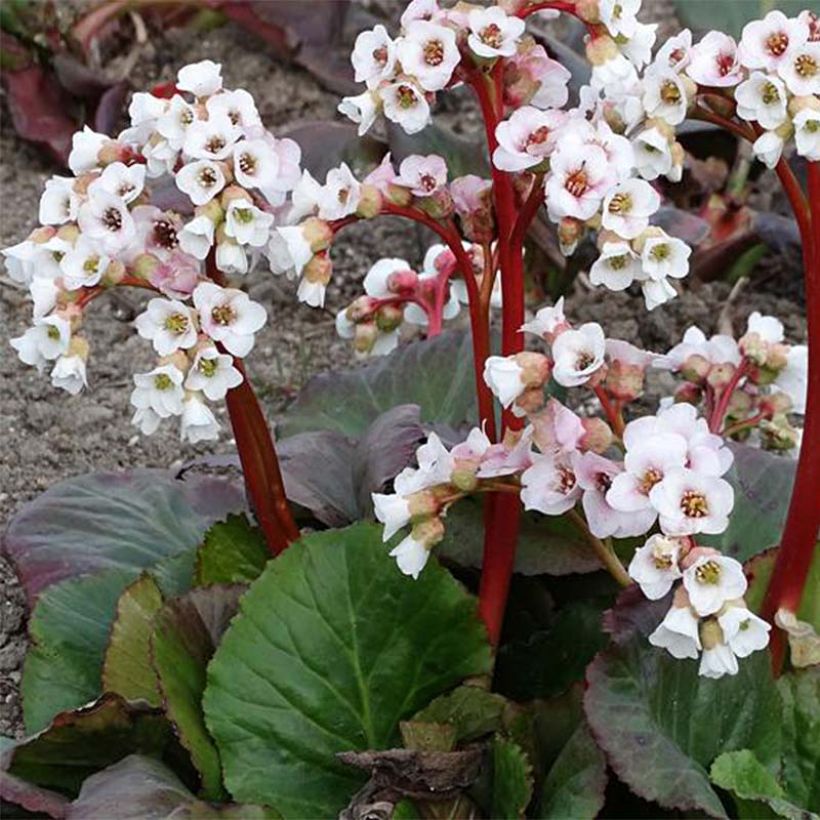

Flowering
Foliage
Plant habit
Botanical data
Bergenia
Jelle
Saxifragaceae
Elephant's Ears, Heartleaf Bergenia, Pigsqueak
Cultivar or hybrid
Other Bergenia
Planting and care
Bergenia 'Jelle' will grow well in most soils, but a soil rich in humus and moist is preferable. Dry soils tend to stop the growth of the plant. It will thrive in shade, partial shade, or sunny but not scorching positions: dense shade, where it does not flower, and strong insolation should be avoided. Cold and poor soils enhance its colours. The clumps can be planted in spring or autumn, with a spacing of 40 to 50cm (16 to 20in). To propagate, the rhizomes can be divided at the end of winter. Although a good fertilizer benefits the growth of this plant, care should be taken not to overly enrich the soil with nitrogen to facilitate flowering. Remove all withered leaves in spring, spread balanced fertilizer after flowering to promote new shoots. Watch out for the appearance of slugs and snails in spring.
Planting period
Intended location
Care
Spring flowering perennials
Haven't found what you were looking for?
Hardiness is the lowest winter temperature a plant can endure without suffering serious damage or even dying. However, hardiness is affected by location (a sheltered area, such as a patio), protection (winter cover) and soil type (hardiness is improved by well-drained soil).

Photo Sharing Terms & Conditions
In order to encourage gardeners to interact and share their experiences, Promesse de fleurs offers various media enabling content to be uploaded onto its Site - in particular via the ‘Photo sharing’ module.
The User agrees to refrain from:
- Posting any content that is illegal, prejudicial, insulting, racist, inciteful to hatred, revisionist, contrary to public decency, that infringes on privacy or on the privacy rights of third parties, in particular the publicity rights of persons and goods, intellectual property rights, or the right to privacy.
- Submitting content on behalf of a third party;
- Impersonate the identity of a third party and/or publish any personal information about a third party;
In general, the User undertakes to refrain from any unethical behaviour.
All Content (in particular text, comments, files, images, photos, videos, creative works, etc.), which may be subject to property or intellectual property rights, image or other private rights, shall remain the property of the User, subject to the limited rights granted by the terms of the licence granted by Promesse de fleurs as stated below. Users are at liberty to publish or not to publish such Content on the Site, notably via the ‘Photo Sharing’ facility, and accept that this Content shall be made public and freely accessible, notably on the Internet.
Users further acknowledge, undertake to have ,and guarantee that they hold all necessary rights and permissions to publish such material on the Site, in particular with regard to the legislation in force pertaining to any privacy, property, intellectual property, image, or contractual rights, or rights of any other nature. By publishing such Content on the Site, Users acknowledge accepting full liability as publishers of the Content within the meaning of the law, and grant Promesse de fleurs, free of charge, an inclusive, worldwide licence for the said Content for the entire duration of its publication, including all reproduction, representation, up/downloading, displaying, performing, transmission, and storage rights.
Users also grant permission for their name to be linked to the Content and accept that this link may not always be made available.
By engaging in posting material, Users consent to their Content becoming automatically accessible on the Internet, in particular on other sites and/or blogs and/or web pages of the Promesse de fleurs site, including in particular social pages and the Promesse de fleurs catalogue.
Users may secure the removal of entrusted content free of charge by issuing a simple request via our contact form.

































